

USB, DC & Solar Lipoly Charger. Is this a Max Power Point Tracker (MPPT)?
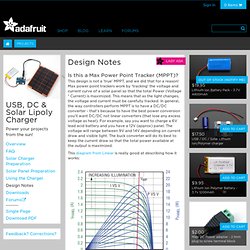
This design is not a 'true' MPPT, and we did that for a reason! Max power point trackers work by 'tracking' the voltage and current curve of a solar panel so that the total Power (Voltage * Current) is maximized. This means that as the light changes, the voltage and current must be carefully tracked. In general, the way controllers perform MPPT is to have a DC/DC converter - that's because to have the best power conversion you'll want DC/DC not linear converters (that lose any excess voltage as heat). For example, say you want to charge a 6V lead acid battery and you have a 12V (approx) panel. This diagram from Linear is really good at describing how it works: The Green lines show the I-V curve of the panel for a given light condition. However, there are some side effects to using a MPPT design.
USB, DC & Solar Lipoly Charger. Make your projects to go green this summer with our specialized USB/Solar Lithium Ion Polymer Battery charger!
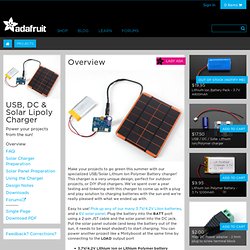
This charger is a very unique design, perfect for outdoor projects, or DIY iPod chargers. We've spent over a year testing and tinkering with this charger to come up with a plug and play solution to charging batteries with the sun and we're really pleased with what we ended up with. Easy to use! Pick up any of our many 3.7V/4.2V LiIon batteries, and a 6V solar panel. Battery Performance Characteristics - How to specify and test a battery. Specifications, Standards and Hype Batteries may be advertised as Long Life, High Capacity, High Energy, Deep Cycle, Heavy Duty, Fast Charge, Quick Charge, Ultra and other, ill defined, parameters and there are few industry or legal standards defining exactly what each of these terms means.
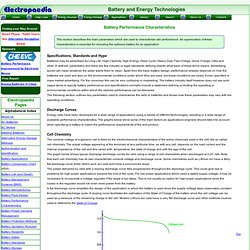
Advertising words can mean whatever the seller wants them to mean. Apart from the basic battery design, performance actually depends on how the batteries are used and also on the environmental conditions under which they are used, but these conditions are rarely, if ever, specified in mass market advertising.
For the consumer this can be very confusing or misleading. The battery industry itself however does not use such vague terms to specify battery performance and specifications normally include a statement defining or limiting the operating or environmental conditions within which the claimed performance can be delivered. Discharge Curves Cell Chemistry Temperature Characteristics Cell Chemistry. NiMH battery charger circuit diagram using LTC4060.
Using the LTC4060 integrated circuit , can be designed a very simple smart NiMH battery charger electronic project .
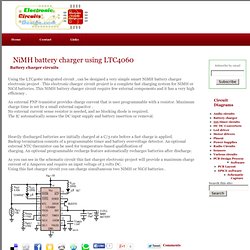
This electronic charger circuit project is a complete fast charging system for NiMH or NiCd batteries. This NiMH battery charger circuit require few external components and it has a very high efficiency . An external PNP transistor provides charge current that is user programmable with a resistor. Maximum charge time is set by a small external capacitor . No external current sense resistor is needed, and no blocking diode is required. Heavily discharged batteries are initially charged at a C/5 rate before a fast charge is applied. As you can see in the schematic circuit this fast charger electronic project will provide a maximum charge current of 2 Amperes and require an input voltage of 5 volts DC.
MintyBoost - Process documentation.
Peltier FAQ. 1.
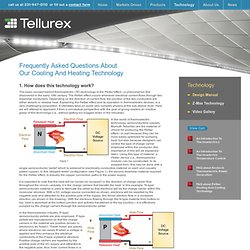
How does this technology work? The basic concept behind thermoelectric (TE) technology is the Peltier effect—a phenomenon first discovered in the early 19th century. The Peltier effect occurs whenever electrical current flows through two dissimilar conductors. Depending on the direction of current flow, the junction of the two conductors will either absorb or release heat. Explaining the Peltier effect and its operation in thermoelectric devices, is a very challenging proposition. Figure 1 In the world of thermoelectric technology, semiconductors (usually Bismuth Telluride) are the material of choice for producing the Peltier effect—in part because they can be more easily optimized for pumping heat, but also because designers can control the type of charge carrier employed within the conductor (the importance of this will be explained later).
Figure 2 In the thermoelectric industry, 'P-type' semiconductor pellets are also employed. 2. Figure 3 Figure 4 Figure 5 Figure 6 Figure 7 3. No. 4. Battery Chargers and Charging Methods. Charging Schemes.
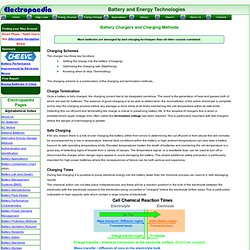
Faraday For Fun: An Electronic Batteryless Dice. There has been a lot of interest in muscle powered electronic devices, due in large part to the success of Perpetual TorchPerpetual Torch, also known as battery-less LED torch.
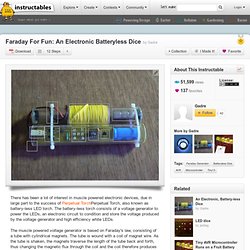
The battery-less torch consists of a voltage generator to power the LEDs, an electronic circuit to condition and store the voltage produced by the voltage generator and high efficiency white LEDs. The muscle powered voltage generator is based on Faraday's law, consisting of a tube with cylindrical magnets. The tube is wound with a coil of magnet wire. As the tube is shaken, the magnets traverse the length of the tube back and forth, thus changing the magnetic flux through the coil and the coil therefore produces an AC voltage. We will come back to this later in the Instructable.
This Instructable shows you how to build an electronic, batterless dice. But first some background ---> Battery Chargers.